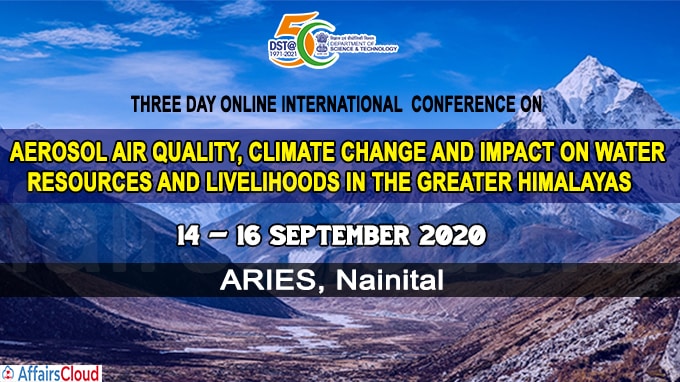 Aryabhatta Research Institute of Observational Sciences (ARIES), Nainital an autonomous research institute under Department of Science and Technology (DST), Ministry of Science and Technology, and Hemvati Nandan Bahuguna Garhwal University (HNBGU), a central university in Srinagar, Pauri Garhwal, Uttarakhand jointly organized an International Conference on ‘Aerosol Air Quality, Climate Change and Impact on Water Resources and Livelihoods in the Greater Himalayas’ at ARIES, Nainital from September 14-16, 2020.
Aryabhatta Research Institute of Observational Sciences (ARIES), Nainital an autonomous research institute under Department of Science and Technology (DST), Ministry of Science and Technology, and Hemvati Nandan Bahuguna Garhwal University (HNBGU), a central university in Srinagar, Pauri Garhwal, Uttarakhand jointly organized an International Conference on ‘Aerosol Air Quality, Climate Change and Impact on Water Resources and Livelihoods in the Greater Himalayas’ at ARIES, Nainital from September 14-16, 2020.
The International Conference will discuss the effect of Aerosols on the Himalayan Regions in India, Nepal and Bangladesh.
The Conference has been organized as part of the celebrations of the Golden Jubilee Commemoration Year of DST. It is the first online international conference to be held at ARIES, Nainital during the Pandemic.
Key Points:
i.Speakers were invited from various parts of the globe and they delivered lectures under the theme of Growing air pollution over the Indo-Gangetic Plains and Central Gangetic Himalayan Region, Himalayan Glaciers, Climate Change impacts on Himalayan Glacier and monsoon over Himalayas and other extreme events.
ii.The presentations reviewed in the Conference will be published on a thematic issue titled “Aerosols-Climate interaction and water resources over the Himalayas” in the Journal of Earth System Science (JESS).
Atmospheric Aerosols:
i.Atmospheric Aerosols (known as particulate matter) are solid or liquid particles suspended in air.
ii.They are originate from both natural (sea salt, desert dust, forest fire) and anthropogenic sources (fossil fuels, biomass vehicular emissions, industrial emission)
iii.Due to Industrialization and urbanization, air pollution and aerosols have been increasing tremendously.
iv.These particles have significant impact on the air quality, visibility degradation, cloud formation, Himalayan Climate, glaciology, monsoon patterns, water availability and human health.
Global hotspots of pollution:
The Indo-Gangetic plains (IGP) and nearby Himalayas are considered as one of the global hotspots of pollution due to natural and anthropogenic emissions.
Causes of Pollution:
i.During the pre-monsoon/summer months, regular dust storms are observed throughout the region and as a result very high concentrations of aerosols and air pollutants are found.
ii.During the post-monsoon/winter months, the region witnesses worst air quality due to crop reduction, biomass and biofuel burning.
iii.The black carbon deposition on glaciers in the Himalayas are important topics for discussion on Pollution in the Himalayas in India, Nepal and Bangladesh.
ARIES, Nainital:
i.ARIES started its research activities in the field of atmospheric science and climate change before two decades.
ii.It has installed a series of modern instruments at Manora Peak, a strategically important location in Central Himalayan Region for measurements of optical, physical and chemical properties of aerosols and Trace Gases ( gases which occur in small concentrations, such as Hydrogen , Helium , Neon, Krypton and Xenon)
iii.It has established National and International collaborations in these areas.
Recent Related News:
i.On June 2, 2020,The Office of the Principal Scientific Adviser (PSA) to the Government of India (GoI) and the Department of Science and Technology (DST) have jointly started the process of consultation for the new & 5th national Science, Technology and Innovation Policy (STIP 2020).
ii.On April 30, 2020, National Council for Science & Technology Communication (NCSTC), Department of Science & Technology (DST) has initiated a programme on health and risk communication focusing on COVID-19 titled “Year of Awareness on Science & Health (YASH)”.
About Aryabhatta Research Institute of Observational Sciences(ARIES):
Director – Dipankar Banerjee
Location – Manora Peak, Nainital, Uttarakhand, India.
About Ministry of Science and Technology:
Union Minister – Dr Harsh Vardhan
Headquarters – New Delhi




